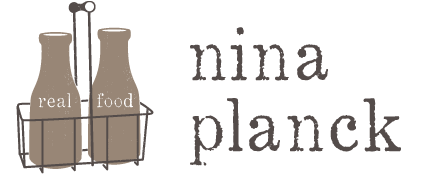Milk Methods: Raw, Cooked or Zapped
12/1/09
Raw milk is a special thing. I love it, but it’s not for everyone, nor is it legal everywhere in the US. To find it, visit www.RealMilk.com, run by the Campaign for Raw Milk, a project of the Weston Price Foundation.
Modern pasteurization takes three main forms: batch or low-temperature, High Temperature Short Time (HTST), and ultra-high temperature (UHT). The batch method heats a vat of milk to 145 degrees Fahrenheit for about thirty minutes. According to Mary and Tim Tonjes, dairy farmers in Callicoon, New York, the batch method is gentle, allowing plenty of good bacteria to survive, which are critical for good yogurt and cheese. Some small dairies use a high-temperature machine called LiLi, invented in 2006 by Steven Judge, a Vermont dairy farmer who was keen to help other small dairy folk thrive. His method heats milk rapidly to 162 degrees Fahrenheit, via tubes and steel plates, for fifteen seconds. The late, lovely Rose Hubbert told me she was the first in New York State to use LiLi. In my region, Tonjes Farm Dairy and Ri’s Dairy of Sullivan County sell unhomogenized milk (and Ri sells excellent ice cream). Both milks are fresh and sweet, and I’ve concluded that both pasteurization methods are the next best thing to raw.
Like dairy farmers and milk drinkers, cheese makers care about how milk is treated. The two main effects of cooking milk – it degrades proteins and caramelizes sugars – adversely affect the flavor and texture of cheese. According to The Cheese Reporter, the high-temperature, short-time method, despite its nominally higher temperature of 162 Fahrenheit, has less detrimental effects, or fewer, on milk than the batch system. This relatively gentle approach looks good for yogurt and butter as well as cheese.
Most milk, however, is treated harshly. UHT milk is subject to high heat (284 Fahrenheit) and pressure for several seconds. UHT milk has a noticeable cooked flavor. The heat damages the whey proteins that contribute to the creaminess. To compensate, congealing agents like guar gum and carrageenan are added to ultra-pasteurized milk to mimic its natural viscosity. UHT treatment has two main advantages: it kills most pathogens stone-dead (undoubtedly a plus when the milk of thousands of cows from confinement dairies is sloshing about the tankers on the highways) and results in a carton of milk with a long shelf life even after it’s opened. When packed in aseptic cartons, UHT milk lasts for six months without refrigeration, and for more than a week once opened. But no decent cheese maker would use UHT milk to make cheese. All UHT milk is homogenized.

